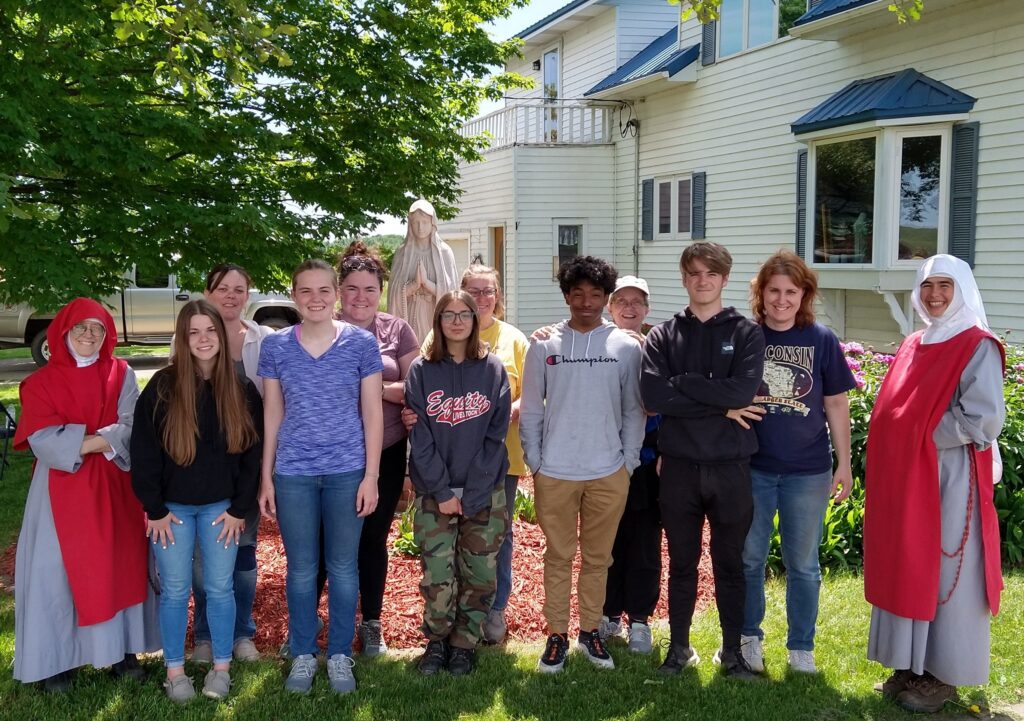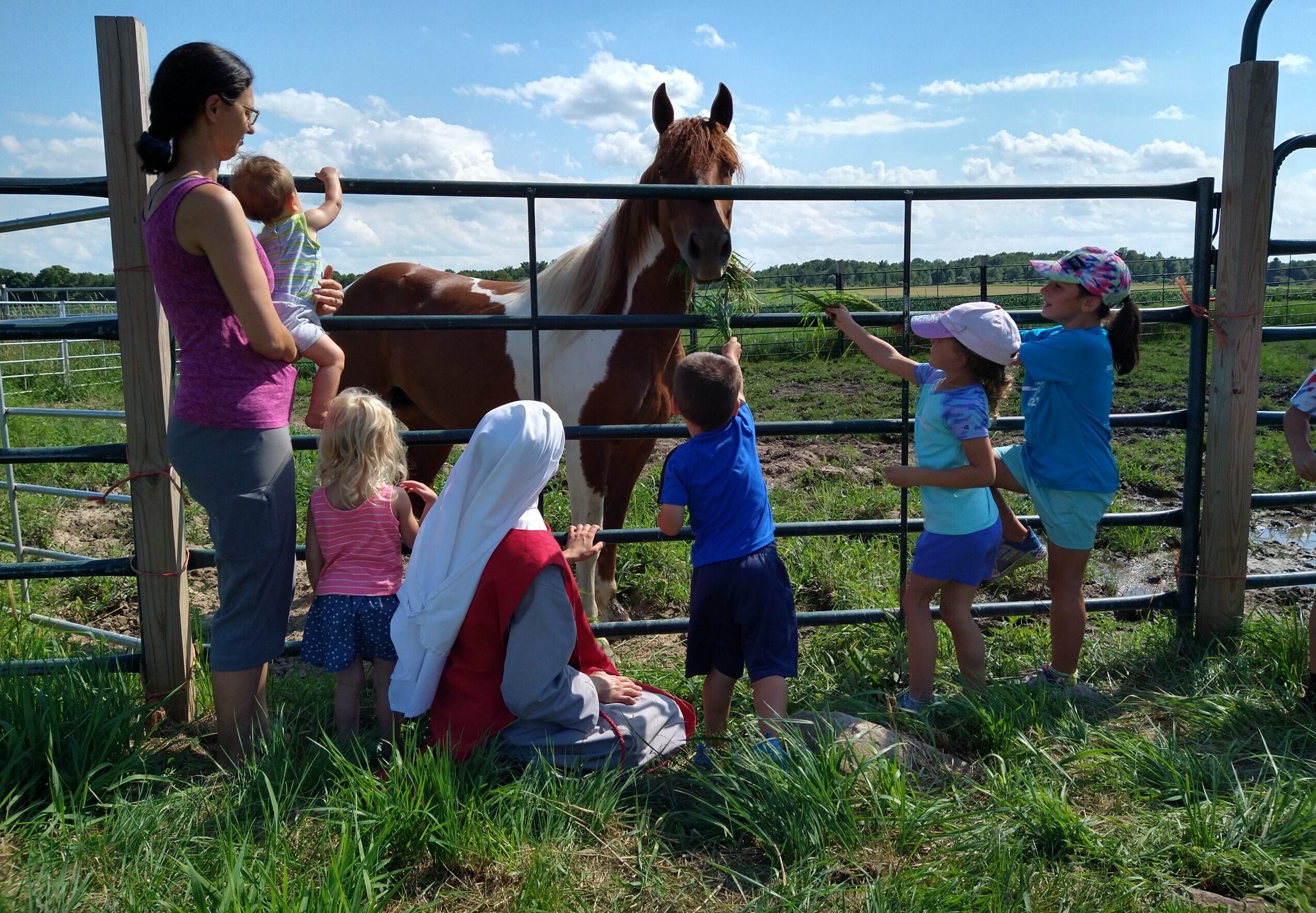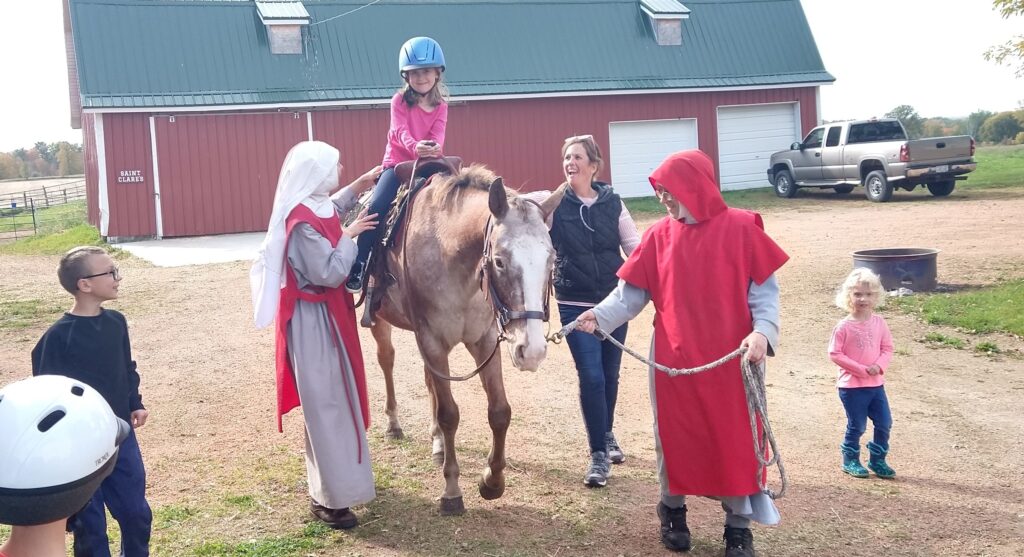Mother Veronica uses animals to help people find peace
On the outskirts of Marshfield is the Merciful Heart of Jesus Farm. A vintage white farmhouse sits just off the main county road surrounded by several large old red barns aptly named to identify the purpose of each one. St. Joseph’s pole shed has a horse therapy arena and St. Clare’s granary has storage for all the supplies. The St. Francis barn houses the all-purpose room, a restroom, and two other small rooms that connect to St. Martin’s Barn and lead to the outside. It also has six volunteer-built horse stalls and a staircase leading up to a massive loft filled with loose hay. There is a nostalgic smell, which is a mixture of century-old barn wood beams, tractor oil, a light animal scent and the dry crispy hay itself. Mother Mary Veronica and Sister Maria Lucia live the religious life and work in this new community called the Franciscan Congregation of Divine Mercy (FCDM).
The FCDM is made up of three aspects. St. Maria Faustina Kowalska’s diary, “Divine Mercy in My Soul,” specifically #1154-1158, is the inspiration. The first aspect is for women called to the cloistered religious life. The second aspect is especially focused towards living mercy and protecting the souls of children against the spirit of evil. It has two branches, one for women called to monastic apostolic religious life and another for lay faithful and secular clergy. The second branch has eight lay members in temporary promises. The third aspect is for those who promise to do one act of mercy a day and to pray for mercy and reconciliation for the world. St. Faustina wrote in #1157, “Everyone in the world can belong to this group.” About 160 people are members of the third aspect.
Mother Veronica’s and Sister Lucia’s habits are white with a red mantle and veil. “This is an image of us being connected to the Lord’s passion,” explains Sister Lucia in reference to #526 of St. Faustina’s diary. “It reminds me about how much He loves us—that He would suffer that much for us.” (Their work attire is slightly different: gray habits with a red scapular.)
“Our life is a life of service,” explains Sister Lucia. “First of all, we live this through prayer and sacrifice on behalf of the Church and the world, and next through our practice of the other spiritual works of mercy. Our farm, horses, dogs, and cats all contribute to our therapy program. We hold children’s programs, spiritual formation classes, and retreats. We visit the dying. Mother Veronica assists individuals, couples, and families through spiritual direction, and also teaches classes on the Catholic Faith virtually. Following her inspiration, everything we do for others, we do free of charge, so we are dependent on donations to continue our ministries. We are grateful to all those who help us. We seek to serve in a spirit of gentleness and joy, and try to foster an atmosphere of fun, particularly in our work with the children and families!” remarks Sister Lucia. “The need is tremendous. If we had more Sisters, we could help so many more people”, says Mother Veronica.
Mother Veronica first felt a call to the religious life during grade school. But around the fifth grade, she decided she wouldn’t be a nun because it would require giving up everything. “I was especially crazy about dogs and horses,” she says. “So I ended up going to college for Light Horse Management. I loved training animals and teaching my students how to train their animals.” At about the age of 25, the “call” had returned, and she decided to let go of everything to become a nun.
While seeking out her calling, she was drawn to St. Faustina and a particular entry in her diary: “Your purpose and that of your companions is to unite yourselves with Me as closely as possible; through love you will reconcile earth with heaven, you will soften the just anger of God, and you will plead for mercy for the world.” (#531) “That was a real ‘God moment’ where I just knew that I had found the community that I was supposed to be in,” says Mother Veronica. “After years of trying to begin the Divine Mercy community, I joined the Poor Clares. As a solemnly professed nun, at times I would feel a nudge in my heart, reminding me of the Divine Mercy call. Even though I tried to push this feeling away, the pull became unbearable.”
The Divine Mercy Call
It was in 2016, with permission from her superiors and Rome, that she left the monastery to come to the Diocese of La Crosse. “Bishop Callahan welcomed me to try to begin a Divine Mercy community here,” she says. “But I had no intention of including therapy animals as part of the work of the community.” Then, she had an inspiration at Mass one day to do dog therapy and shared this inspiration with the Mother Abbess of her former monastery who mentored her at Bishop Callahan’s request. Mother Abbess was very excited, declaring it a “truly unique charism” and sent a letter expounding the use of therapy animals as part of the community’s mission. “I began to receive more confirmations that God did want animals to be involved in the work of our community,” says Mother Veronica.
At around this same time, Mother Veronica discovered positive reinforcement training and everything made sense to her. “Training has advanced since I entered the cloister. This positive reinforcement method was exactly what I had dreamed about as a child,” she says. “Forcing an animal to do something didn’t feel right. Animals are often forced to do things through fear … so are people. Positive reinforcement uses classical conditioning, which affects what emotion the animal or person will feel when seeing or experiencing something,” she explains. “An animal can be classically conditioned to enjoy something that it would naturally be fearful of without using force or fear. They will choose to want to do their trained behaviors freely. Learning this new positive way to work with others is life transforming. The whole thing is just so amazing! Looking back, I didn’t understand some things about God’s will when I was a riding instructor, but I realize now, God was showing me that working with animals and people was going to be fruitful for Him. Now I’m much better trained in religion and much better trained with animals. Learning this new positive way to work with others is life transforming. It teaches a way of life that heals and spreads gospel love.”
In 2017, Mother Veronica took up residency at the old rectory of Corpus Christi Church in Bakerville, just south of Marshfield. She had one dog, a German Shepherd. Shortly thereafter, a discerning college girl attended Mother’s spiritual classes and began her own discernment process with the Franciscan Congregation of Divine Mercy. The two often prayed vespers and shared simple meals together. Now, as Sister Lucia, she says there was no exact moment where it was overwhelmingly clear what she was supposed to do with her life. But one of the things that drew her in during her discernment process was the young community’s focal mission of reconciling relationships with self, God and others. “This certainly had a draw and interest for me,” says Sister Lucia. “My discernment process is still continuing, but I really enjoy the work and especially working with the children.”
In 2019, the sisters had accumulated enough donations to put a down payment on their current location, but still needed funding to maintain the monthly mortgage. They currently have 10 horses at the farm. Two are domestic but the others, all Mustangs, came from the Bureau of Land Management from western states like Nevada, California and Idaho. Wild horses are usually rounded up with helicopters and are split from their family groups. This is usually quite traumatizing. “The participants in the horse training program learn to train the horses and to be an instrument of their healing through positive reinforcement training,” says Mother Veronica. “It also teaches a way of life that heals and spreads gospel love.” All the horses are named after saints, like Margaret Mary, Catherine, Faustina and Agatha. “Except one, who is named after the angel St. Raphael,” says Mother Veronica. “The cats are named for attributes of God, and our dog is named for the theological virtue of faith.”
The sisters’ day begins at 5 a.m. when they rise and feed the horses and put them outside. Then the sisters go out for 7 a.m. Mass, usually praying in the car to and from church and errands they may have. “Currently, three days a week, we have a volunteer stall-cleaner. But often I’m the stall cleaner,” laughs Mother Veronica. At mid-day, they pray in the chapel. Time spent in adoration could be in the morning or the evening, depending on the day’s events. “Our schedule has to be rather fluid because some mornings I have spiritual direction,” says Mother Veronica. On Wednesday mornings they have “Farm Fun with the Sisters,” and almost every afternoon there is someone coming for horse therapy time. After chores in the evening, they have vespers, mealtime, more prayer and sometimes spiritual formation classes. It’s not uncommon for Mother Veronica to be up until 11 p.m. or later giving spiritual direction. “I love to try to help people to really live the Gospel of Mercy,” she says.
Learning the “Calm-Default”
In the horse arena, Mother Veronica teaches children positive reinforcement training and how to “listen” to the horse, understanding its body language. “Our program is about training. This is made clear from the start. Most older girls here would rather train a horse to ride than have a horse that is already trained to ride,” Mother explains. “It’s about the process. The healing comes, the insights come, when they work with the horse. They learn things about themselves and their own fears. As they see the effectiveness of the new philosophy taught to them, it naturally leads them to reconcile their relationships with self, others and God, which is the charism of our community along with living mercy.”
Lucy, an 18-year-old domestic horse, is very well trained but shows signs of fear with things concerning riding. “The children who work with her are using classical conditioning and counterconditioning to change her emotions from a fear reaction to a happy anticipation of good things to come,” explains Mother Veronica. “Emotionally, she is starting to get interested in riding and things concerning riding. In the end, both the horse and rider will be able to have fun.” During another short training exercise, Mother Veronica works with four girls and an almost black mare named Agatha. Using a halter, bareback pad and blanket, they work on self-bridling skills to prepare her for riding. This training is repetitive and requires a lot of patience and awareness of the body language of the horse and trainer. Mother Veronica marks positive behavior with a quick vocal ‘yes’ and a small piece of hay cube for a reward.

During training sessions, there is ample use of “calm-default.” The horse learns that if it gets no direction to do anything else, it should default to standing calmly. “Calm-default should be practiced the most so that the animal realizes that standing still and being calm is the best thing to do,” explains Mother Veronica. “Agatha tends to want to volunteer behavior, which means the horse wants to do extra tricks to make the person give her a food reward. For the horse, and the children, actions are more fun than standing calmly, but both end up seeing the value in calm-default. It helps the children and the horse to be more comfortable.”
“Working with the horses teaches self-regulation and prayer, which are both wonderful skills,” says Mother Veronica. In her training, she also inserts calming moments for people, too. Giving direction, she says, “Everybody in here, breathe in slowly and out even slower. I want you to try to be in the presence of God. Try to be with God in your heart. The horse will feel our calmness and calm down, too.” When the children did the exercise, Agatha stopped pacing and dropped her head. Mother asked, “Did you see that?”
Unfortunately, the sisters are limited to what they can handle with just the two of them so they are very appreciative of all the volunteers and their hard work and the generous donors and benefactors who provide funds and supplies that keep them operational.
On vocational discernment, Mother Veronica advises, “Seek God’s will, be bold enough to take risks and to commit yourself totally to God. There’s no better spouse than Jesus. It’s a wonderful life.” To learn more about The Sisters of the Franciscan Congregation of Divine Mercy or to contribute to their mission and community, visit their website: fcofdivinemercy.org.
Story by Marcy Stenstrom
Published in the July/August 2023 issue of Catholic Life Magazine




